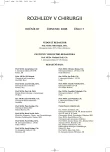Re-expansion Pulmonary Edema as a Complication of a Spontaneous Pneumothorax Drainage – a Case Review
Authors:
T. Toporcer; J. Iľková; L. Lakyová; J. Belák; J. Radoňak
Authors‘ workplace:
II. chirurgická klinika, LF, UPJŠ, Košice, Slovenská republika, prednosta: MUDr. J. Belák, Ph. D.
Published in:
Rozhl. Chir., 2008, roč. 87, č. 7, s. 347-351.
Category:
Monothematic special - Original
Overview
Reexpansion pulmonary edema is an iatrogenic complication occurring after reinflation of the collapsed lung of a patient with pneumothorax or fluidothorax. The following risk factors have been associated with reexpansion pulmonary edema: younger age, longer duration of a lung collapse, its large extend and a quick lung reexpansion.
We report a case of 26-years-old man. The patient was admited to the second surgical clinic FNLP, Košice because of a spontaneous pneumothorax. A chest tube was inserted in local anesthesia in the right anterior axilar line and the fourth intercostal space. An active negative pressure of 20 cm H₂O was applied. Dyspnea, decrease of blood pressure, tachycardia, tachypnoe and expectoration of pink sputum were recorded after negative pressure application. Oxygen saturation decreased to 90% despite the addition of oxygen. Glucocorticoids, diuretic stimulants, analgesic and bronchodilatators were administered. Chest X-rays and computer tomography showed a strong ipsilateral pulmonary edema and an incipient contralateral pulmonary edema. The patient was stabilized and after 16 hours continuous oxygen administration was not longer needed. Because of continuous pneumothorax, a video assisted thoracoscopic surgery was performed on the seventh day after the chest tube insertion. After 13 days of hospitalization the patient was discharged in good condition without any further complications to the ambulatory care.
Reexpansion pulmonary edema is a rare complication of the chest tube insertion and thoracocentesis because of pneumothorax and fluidothorax. The mortality of reexpansion pulmonary edema reaches up to 20%. Chest tube insertion and thoracocentesis are therapeutic procedures to be performed solely on medical department which can provide artificial lung ventilation.
Key words:
reexpansion pulmonary edema – spontaneous pneumothorax – chest tube insertion
Sources
1. Kelly, A. M. Review of management of primary spontaneous pneumotorax: is the best evidence clearer 15 years on? Emerg. Med. Australas., 2007; 19: 303–308.
2. Neustein, S. M. Reexpansion pulmonary edema. J. Cardiotorac. Vasc. Anesth., 2007; 21: 887–891.
3. Feller-Kopman, D., Berkowitz, D., Boiselle, P., et al. Large-volume toracocentesis and the risk of reexpansion pulmonary edema. Ann. Torac. Surg., 2007; 84: 1656–1661.
4. Carlson, R. I., Classen, K. L., Gollan, F., et al. Pulmonary edema following the rapid reexpansion of a totally collapsed lung due to a pneumotorax: a clinical and experimental study. Surg. Forum, 1958; 9: 367–371.
5. Conen, A., Joos, L., Bingisser, R. Ipsilateral reexpansion pulmonary edema after drainage of a spontaneous pneumotorax: a case report. J. Med. Case Reports., 2007; 1: 107–107.
6. Tan, H. C., Mak, K. H., Johan, A., et al. Cardiac output increases prior to development of pulmonary edema after re-expansion of spontaneous pneumotorax. Respir. Med., 2002; 96: 461–465.
7. Her, C., Mandy, S. Acute respiratory distress syndrome of the contralateral lung after reexpansion pulmonary edema of a collapsed lung. J. Clin. Anesth., 2004; 16: 244–250.
8. Mahfood, S., Hix, W. R., Aaron, B. L., et al. Reexpansion pulmonary edema. Ann. Torac. Surg., 1988; 45: 340–345.
9. Saito, S., Ogawa, J., Minamiya, Y. Pulmonary reexpansion causes xanthine oxidase-induced apoptosis in rat lung. Am. J. Physiol. Lung Cell Mol. Physiol., 2005; 289: 400–406.
10. Henry, M., Arnold, T., Harvey, J. BTS guidelines for the management of spontaneous pneumotorax. Torax, 2003; 58: 39–52.
11. Janik, M., Belak, J., Sauka, C., et al. Spontánny pneumotorax. Niekoľko aktuálnych pohľadov. Rozhl. Chir, 1999; 78: 120–122.
12. Vodička, J., Spidlen, V. Spontánní pneumotorax. Čas. Lék. Česk., 2006; 145: 611–615.
13. Zehtabchi, S., Rios, C. L. Management of emergency department patients with primary spontaneous pneumotorax: needle aspiration or tube toracostomy? Ann. Emerg. Med., 2008; 51: 91–100, 100.
14. Baumann, M. H., Strange, C., Heffner, J. E., et al. Management of spontaneous pneumotorax: an American College of Chest Physicians Delphi consensus statement. Chest, 2001; 119: 590–602.
15. Habal, P., Šimek, J., Novotný, J. Chirurgická léčba pneumotoraxu. Acta Medica. (Hradec Králové) Suppl., 2004; 47: 47–53.
16. Zeman, M. Speciální chirurgie (2. vydání). Praha, Galen, 2006, 575 s.
17. So, S. Y., Yu, D. Y. Catheter drainage of spontaneous pneumotorax: suction or no suction, early or late removal? Torax, 1982; 37: 46–48.
18. Baumann, M. H. Management of spontaneous pneumotorax. Clin. Chest Med., 2006; 27: 369-381.
19. Shaw, T. J., Caterine, J. M. Recurrent re-expansion pulmonary edema. Chest, 1984; 86: 784–786.
20. Cho, S. R., Lee, J. S., Kim, M. S. New treatment method for reexpansion pulmonary edema: differential lung ventilation. Ann. Torac. Surg., 2005; 80: 1933–1934.
21. Tariq, S. M., Sadaf, T. Images in clinical medicine. Reexpansion pulmonary edema after treatment of pneumotorax. N. Engl. J. Med., 2006; 354: 2046.
22. Grendel, T., Hudák, V., Firment, J. Nízke dávky kortikoidov a septický šok. Rozhl. Chir., 2008; 87: 158–164.
Labels
Surgery Orthopaedics Trauma surgeryArticle was published in
Perspectives in Surgery

2008 Issue 7
- Metamizole vs. Tramadol in Postoperative Analgesia
- Metamizole at a Glance and in Practice – Effective Non-Opioid Analgesic for All Ages
- Current Insights into the Antispasmodic and Analgesic Effects of Metamizole on the Gastrointestinal Tract
Most read in this issue
- Pectoralis Maior Tendon Rupture and Anabolic Steroids in Anamnesis – a Case Review
- Re-expansion Pulmonary Edema as a Complication of a Spontaneous Pneumothorax Drainage – a Case Review
- Rare Cases of Extensive Retroperitoneal Liposarcomas
- Stents – Paliative and Curative Management of Esophageal Conditions. Seven-Year Surgical Experience
